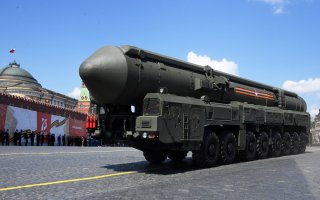Kedr Can Kill: Russia Is Working on a New Nuclear ICBM
According to the source, the solid-fuel Kedr ICBMs will eventually replace the current Yars systems by the early 2030s. Similar to the predecessor ICBM platforms, the new system will have mobile and silo-based modifications, the source added.
According to data from a 2017 Defense Intelligence Agency (DIA) report, "Russia retains about 1,200 nuclear warheads for ICBMs." While many of the platforms are decades old, dating to the Soviet era, since 1998 Russia has been modernizing its Intercontinental Ballistic Missile (ICBM) force, replacing legacy Soviet systems with more modern platforms.
Now it looks as if those efforts are continuing, and Tass reported that the development of Russia's new-generation Kedr ICBM will begin by late 2023 or early 2024.
"Research work on Kedr has been financed under the current state arms procurement program, which is in effect until 2027," a Russian defense industry source told state media. "Technological development will begin in 2023-2024."
According to the source, the solid-fuel Kedr ICBMs will eventually replace the current Yars systems by the early 2030s. Similar to the predecessor ICBM platforms, the new system will have mobile and silo-based modifications, the source added.
At the time of publication, Tass had been unable to obtain an official comment from the Moscow Institute of Thermal Technology, which had developed the Topol, Topol-M and Yars strategic missile systems that are currently in service with the Russian armed forces. However, a source in the space industry told Tass on March 1 that Russian defense companies had launched engineering drafting work on the new-generation Kedr intercontinental ballistic missile system.
Even as the Kedr ICBMs enter service it is unlikely to increase the number of weapons that Russia operates. Instead, it will likely continue to be part of the ongoing modernization efforts.
The Russian Strategic Missile Troops operate a number of road-mobile ICBMs, including the aging Topol. Moscow has maintained the mobile platforms, which date back to Soviet nuclear doctrine. It was seen that mobile platforms would be much more difficult to locate, track, target, and destroy than their silo-fixed counterparts. Mobile ICBMs are thus a key source of strategic redundancy, offering a survivable alternative if the other parts of the Soviet nuclear triad fail.
Precise estimates vary, but it is generally believed that Russia’s Armed Forces possess around forty-five Topol, sixty Topol-M, and as many as 135 mobile Yars systems.
As previously reported, the Kremlin has set a goal to replace all Topol systems with the Topol-M by the early 2020s; a fairly realistic goal assuming that Russia is able to sustain its current modernization pace. The Topol-M missiles have a lifetime between fifteen and twenty years.
Additionally, the RS-24 Yars, or SS-27 Mod 2, is widely believed to be a Topol-M variant equipped with three multiple independent reentry vehicle (MIRV) warheads. Precise deployment details remain is unknown, but analysts believe that Yars exists in both mobile and silo-based variants.
Now it appears that Russia could look to further upgrade and enhance its ICBM capabilities with the recently announced Kedr. Yet given that nothing arrives on time from Moscow, it is likely those ICBMs won't begin to enter production until the latter half of the 2030s at the earliest.
Peter Suciu is a Michigan-based writer who has contributed to more than four dozen magazines, newspapers and websites. He regularly writes about military small arms, and is the author of several books on military headgear including A Gallery of Military Headdress, which is available on Amazon.com.

